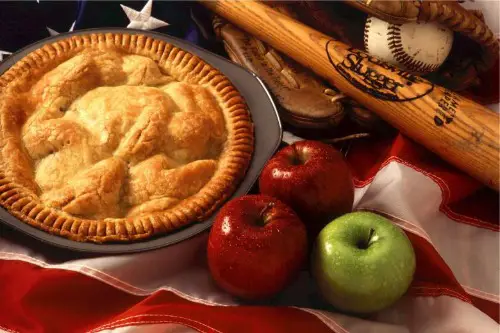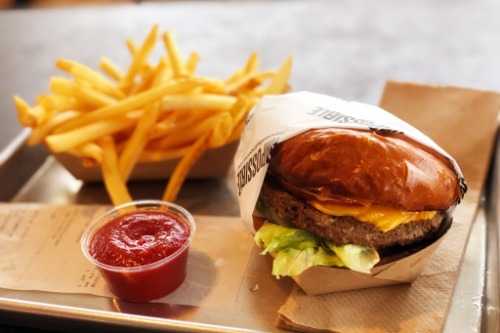1. Apple Pie

Apple pie is often called “as American as apple pie,” but the truth is, this beloved dessert was brought to the U.S. by European settlers, according to Rossi Anastopoulo from Food52. The recipe has roots in medieval Europe, with versions of fruit pies being baked long before they became a staple of American kitchens. Dutch settlers, in particular, are credited with popularizing apple pie in the U.S. So while apple pie has been fully embraced as a symbol of Americana, its origins are far from homegrown.
Over the years, apple pie has become more distinctly American, especially in the way it is presented and served, often with a scoop of vanilla ice cream. The phrase “American as apple pie” took hold during the 20th century, as apple pie became a cultural icon tied to American family traditions. Despite its European ancestry, it’s now woven into the fabric of U.S. identity. It’s a prime example of how a dish can take on a life of its own, making its origins a bit hard to trace.
2. The Hot Dog

The hot dog is a quintessential American food, often associated with baseball games and summer barbecues, but its roots actually trace back to Germany, according to Gregory Lewis McNamee from Britannica. German immigrants brought their sausages to the U.S. in the 1800s, and over time, they became a staple of American fast food. While the specific style of the hot dog we know today—served in a bun with mustard, ketchup, or relish—was popularized in cities like New York, its origins are undeniably European. The term “hot dog” itself likely came from the German “frankfurter,” referring to sausages from Frankfurt.
Though the hot dog has become a symbol of American street food, it’s really an example of how cultural exchange shaped what we now consider an American classic. Americans have added their own twists over the years, turning it into an all-American icon in the process. It’s the perfect example of how food can travel the world and evolve, gaining new cultural significance along the way. The hot dog has been so integrated into American culture that it’s hard to imagine a summer without one.
3. Pizza

Pizza is another food item that feels incredibly American, yet its origins are undeniably Italian. While Italy is the birthplace of pizza, it wasn’t until Italian immigrants brought it to America in the late 19th and early 20th centuries that it became a widespread phenomenon, according to Sabina Montevergine from La Cucina Italiana. In the U.S., pizza began to evolve into the various regional styles we know today, like New York-style thin crust and Chicago deep dish. The American version of pizza, with its variety of toppings and larger portion sizes, is distinct from the Italian classic.
Pizza quickly became a popular dish across America, especially with the rise of fast food culture in the mid-20th century. Its widespread availability, along with its ability to be customized to fit local tastes, made it an American favorite. Over time, pizza has taken on new forms, from frozen versions to artisanal varieties. But at its heart, pizza is still a product of the Italian immigrants who brought their culinary traditions to America.
4. The Hamburger

The hamburger is often considered one of the most iconic American foods, but its roots actually lie in Germany, with the Hamburg steak, according to Hannah Walhout from Food & Wine. German immigrants brought the concept of ground beef patties to the U.S. in the 19th century, where it was adapted and served between two pieces of bread. The hamburger as we know it today, with cheese, lettuce, and condiments, came about in the early 20th century, largely due to the rise of fast food chains. The invention of the burger patty in a bun is credited to various American entrepreneurs, each putting their own spin on it.
While it has become a central part of American culture, especially in fast food, the hamburger’s origins are international. As American culture spread globally, so did the hamburger, becoming a symbol of the U.S. worldwide. Today, you’ll find burgers in countless variations, from gourmet creations to simple, classic versions. Despite being associated with American identity, the hamburger’s roots in Germany are a reminder of how food evolves across borders.
5. Bagels

The bagel, a staple of American breakfasts, was actually brought to the U.S. by Eastern European Jewish immigrants, according to Erin Blakemore from National Geographic. The origins of the bagel date back to Poland in the 16th century, where it was originally created as a circular bread product. In the U.S., bagels became especially popular in cities like New York, where they became a central part of the Jewish-American experience. It wasn’t until the mid-20th century, with the rise of bagel shops and chains, that bagels became a mainstream American food.
While the bagel may be most closely associated with New York, it’s a product of a cultural blend, combining European baking traditions with American innovation. The bagel’s evolution in America is a great example of how immigrant foods can be embraced, transformed, and eventually integrated into the mainstream. From the classic lox and cream cheese topping to modern variations like everything bagels, Americans have put their own spin on this centuries-old food. The bagel is now a breakfast favorite, but its roots are distinctly European.
6. Tea

While tea has been enjoyed in many parts of the world for centuries, it wasn’t until the 17th century that it made its way to America. However, Americans’ relationship with tea is complicated. The Boston Tea Party of 1773, a protest against British taxation, led to the brief rejection of tea by many Americans. Over time, though, tea became more deeply ingrained in American culture, especially in the South, where iced tea emerged as a summer staple.
Iced tea, in particular, became an American invention, and it’s now commonly served with lemon, sugar, or sweeteners. It’s a beverage that has undergone significant transformation from its European roots, largely due to the American penchant for inventing refreshing variations of drinks. Today, tea remains a beloved beverage across the U.S., with a particular love for sweet iced tea in the South. So, while it’s a global drink, it has definitely been Americanized over time.
7. The Concord Grape

The Concord grape, often associated with American culture for its use in juices and jams, was actually developed by a man named Ephraim Wales Bull in Concord, Massachusetts, in the 19th century. While grapes have been grown in Europe for millennia, Bull’s variety was a distinctly American innovation. He cultivated the Concord grape by crossing native American grapes with European varieties, resulting in a sweet, aromatic grape that was perfect for making juice and jellies. The grape became a symbol of American ingenuity, especially after it gained popularity with products like Welch’s grape juice.
The Concord grape quickly became a central part of American agriculture, especially in areas like the Midwest and Northeast. Today, it’s still commonly associated with American-made grape juice and wines, but it’s far from the only type of grape grown in the U.S. The Concord grape’s unique flavor profile made it a favorite for sweet, bold products. Despite being homegrown, it’s a hybrid creation that reflects the combination of old-world and new-world agricultural practices.
8. The Martini

Though the martini is a classic American cocktail, it’s actually believed to have originated in Italy or France before finding its way to the U.S. The drink likely began as a variation of an older Italian gin-based cocktail called a “gin and vermouth.” When it reached America, it was further refined, especially in the early 20th century, as it became popular in cocktail culture. The modern martini, typically made with gin or vodka and dry vermouth, became a signature drink of the American upper class, especially in cities like New York.
Though it’s long been associated with American sophistication, the martini’s roots can be traced back to European cocktail culture. Over time, it became a symbol of the Prohibition era, a drink of choice for those sneaking a tipple in speakeasies. The martini’s evolution in the U.S. makes it uniquely American in flavor, but its origins lie in the European tradition of cocktail-making. Today, the martini continues to be an iconic drink, even though its journey to fame was influenced by multiple countries.
9. Tacos

Tacos, often considered one of the most iconic Mexican foods in America, are deeply rooted in Mexican culinary tradition. However, their widespread popularity in the U.S. is a relatively recent phenomenon. Mexican immigrants brought tacos to America in the early 20th century, but they didn’t truly become a staple of American cuisine until the rise of taco chains in the mid-20th century. American versions of tacos have taken on new forms, from hard-shell tacos to creative fillings and toppings that were never part of the traditional Mexican recipe.
While tacos have their roots firmly planted in Mexican culture, they have evolved in the U.S. to become a part of mainstream American food culture. The rise of fast-food Mexican restaurants and the taco truck movement has further cemented tacos as a beloved American food. American tacos often feature a mix of ingredients that aren’t typically found in traditional Mexican tacos, such as ground beef, lettuce, and shredded cheese. It’s a great example of how food traditions can cross borders and be adapted into something new and uniquely American.
10. The Fork

While forks have been used as eating utensils in many parts of the world, it was Italy that introduced the fork to Europe in the 11th century. The use of forks spread slowly across Europe, with France and England adopting them much later. By the time they arrived in America in the 17th and 18th centuries, forks were considered an essential tool for refined dining. The utensil became so ingrained in American culture that it’s hard to imagine a meal without one.
The fork’s journey to America was largely shaped by European aristocracy and their dining customs. Early American settlers, influenced by European dining etiquette, adopted the fork as part of their own culinary practices. Over time, the fork became so synonymous with American dining that it’s now considered a standard utensil for most meals. It’s an example of how dining customs and tools were imported from Europe and adapted to American society.
11. French Fries

Despite their name, French fries actually have Belgian roots, with the dish being a staple in Belgian and French cuisine. The name “French fries” came about when American soldiers stationed in Belgium during World War I tasted the fried potato dish and mistakenly attributed it to France. The dish quickly became popular in the U.S., especially after fast food chains began offering fries alongside burgers. Over time, French fries evolved into an essential part of American fast food culture.
Though they were popularized in the U.S. through American innovation and fast food, French fries are not an American invention. The popularity of French fries in the U.S. speaks to the American love for convenience and the rise of the fast food industry in the 20th century. Today, French fries are served in a variety of styles and are one of the most universally recognized side dishes in American dining. This small culinary import has become a true American staple.
12. The Champagne Toast

The champagne toast, often associated with celebrations and New Year’s Eve in America, originated in France. Champagne itself, a sparkling wine produced in the Champagne region, became a symbol of luxury and celebration in French aristocracy. As French culture and customs spread to America, the champagne toast was adopted as a way to mark special occasions. By the early 20th century, it became the go-to drink for toasts, especially at weddings, New Year’s celebrations, and other significant moments.
The association of champagne with celebration and joy became so ingrained in American culture that it’s now a symbol of success and happiness. Though champagne toasts are still tied to the traditions of France, Americans have embraced this practice as their own. The act of raising a glass and toasting has evolved into an important social ritual, with champagne often being the drink of choice. It’s a great example of how European traditions became interwoven with American celebrations, adding an element of sophistication to festive moments.
13. Croissants

Croissants, often thought of as an essential part of an American breakfast or brunch, are quintessentially French in origin. They originated in Austria as kipferl, a crescent-shaped pastry, but were popularized in France, where they became a hallmark of Parisian patisserie. It wasn’t until French immigrants brought them to the U.S. that croissants became widely popular in American bakeries and cafes. In the U.S., croissants were quickly embraced, especially with the rise of coffee culture in the 20th century.
While croissants may now be found in nearly every American bakery, they are not native to the U.S. The American version of the croissant, often filled with chocolate or almond paste, has become more decadent than its French predecessor. Croissants have become so ubiquitous in American culture that they are now seen as a breakfast or brunch staple, despite their foreign origins. It’s an example of how foreign foods can be transformed into American favorites through adaptation and widespread adoption.
14. Sushi

Sushi is another food that feels incredibly American, especially in cities like Los Angeles and New York, where sushi bars have become mainstream. However, sushi has deep roots in Japan, where it dates back to the 8th century as a method of preserving fish. The sushi we recognize today, with its combination of raw fish, rice, and sometimes vegetables, didn’t reach the U.S. until the mid-20th century, when Japanese immigrants began opening sushi restaurants in cities like Los Angeles. It was around this time that sushi began to take on American characteristics, such as the creation of rolls with cooked ingredients like tempura.
In the U.S., sushi has gone through numerous reinventions, with the California roll and other fusion varieties becoming popular nationwide. The American embrace of sushi is a perfect example of how a traditional food can be transformed to cater to new tastes and preferences. While sushi remains a Japanese culinary tradition at its core, its American adaptation has made it one of the country’s most popular and accessible international foods. Today, sushi bars can be found in nearly every major city, reflecting how the U.S. has fully embraced this global delicacy.


